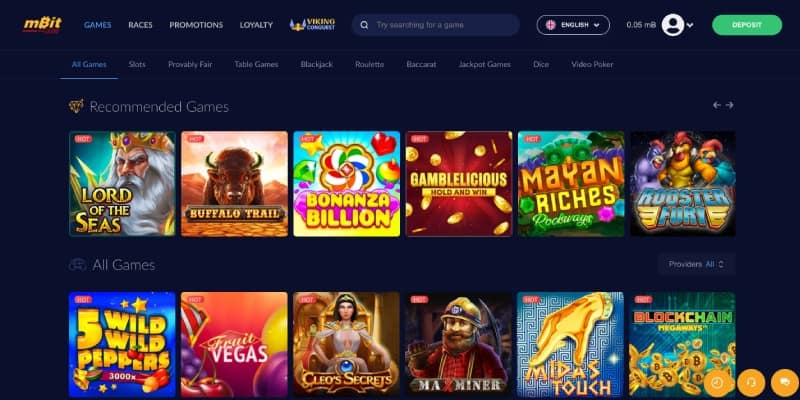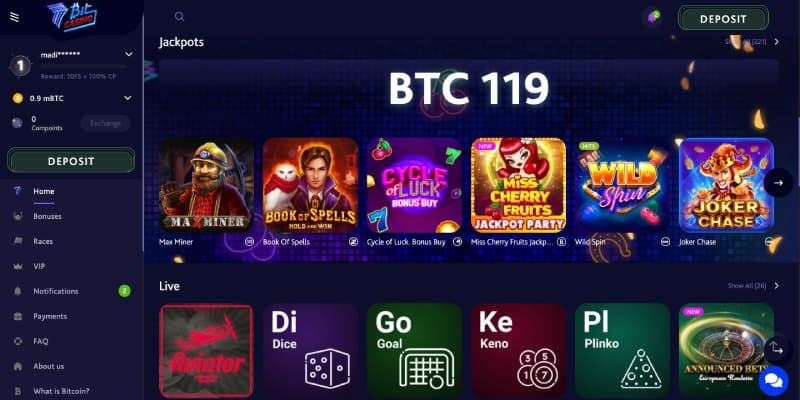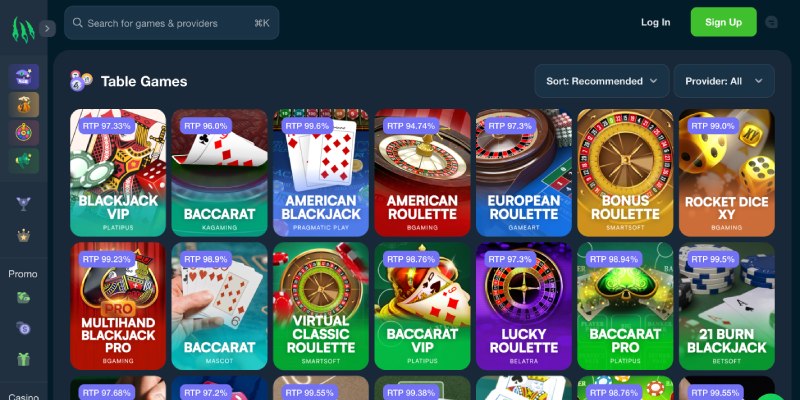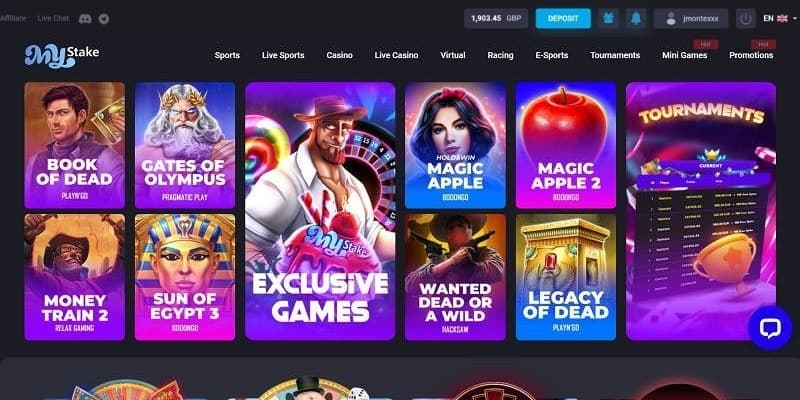Instant payouts, zero fees, and more exciting games and bonuses than anywhere else – all of this is available at the best Bitcoin casinos.
And guess what? We’ve got a list of them here!
Our top pick is Shazam, but there are more crypto casino sites to take a look at in this guide.
The top online BTC casinos reviewed below accept crypto deposits via BTC, BCH, ETH, Dogecoin, and many more altcoins — and you’re guaranteed an epic bonus regardless of which one you decide to use.
Let’s check them out.
Best Bitcoin Casinos
All of these top Bitcoin casinos come with a unique set of features and bonuses that set them apart from others. Our reviews below will help you select the best casino for your needs.
1. Shazam – Best Bitcoin Casino Overall

Pros:
- 260% welcome bonus + 40 free spins
- extra +20% boost for crypto deposits
- Near-instant crypto cashouts (BTC, ETH, LTC)
- Strong mobile experience with tight security
- Themed tournaments and VIP cashback
- Works with reputable software studios
Cons:
- Game filters could be more granular
- The “magic” look isn’t for everyone
Shazam nails the Bitcoin casino fundamentals: frictionless crypto banking, a real first-deposit boost, and a mobile site that just works; that’s why it earned the top spot on our list.
Game Variety: 4.9/5
At the best Bitcoin casino site, you get a deep mix of modern slots, classic tables, video poker, jackpots, and a busy live section.
Blackjack, roulette, and baccarat sit alongside specialty titles, with new releases landing regularly. It’s broad enough for casual sessions and focused enough for grinders who stick to a few favorites.
Bonuses and Promotions: 4.9/5
New players are greeted with a 260% welcome bonus + 40 FS. Free spins are credited for Dreamcatcher or Wild Wild Safari. Terms are straightforward, with just a $25 minimum deposit.
If you fund with crypto, you snag an extra 20% on top of the match. After the opener, look out for daily offers, reloads, and VIP cashback that scale with play.
Crypto Deposits & Withdrawals: 4.9/5
Deposits and withdrawals in Bitcoin, Ethereum, and Litecoin are the fastest route here. Payout requests are approved quickly and hit the chain without fuss, with transparent limits posted in the cashier and no surprise fees. Cards and other methods are available, but crypto is the clear winner for speed.
Grab your 260% + 20% crypto offer
2. Super Slots – Top Online Casino Bitcoin Site for Slot Games

Pros:
- 300 free spins welcome offer
- Over 800 high-quality slots from top providers
- 100 free spins available to claim every week
- 15 crypto banking options available
- Very responsive, 24/7 live chat support
Cons:
- The website can be challenging to navigate
- Some games can’t be played on mobile
There are tons of ways to get your hands on free spins as a Super Slots player. But you don’t have to be a fan of the slots to get something out of this site – even though slots are what this casino does best.
Game Variety: 4.9/5
At Super Slots, players can play Bitcoin casino games with titles from creators like Betsoft, Gala Interactive, and Magma.
Over 800 of these are slot games, and they span a huge range of different styles. Expect progressive jackpots and games with large max wins.
Bonuses and Promotions: 4.9/5
All new players at Super Slots get 300 free spins as a welcome offer. While returning players can get up to 100 free spins on Wednesdays. That’s just one of the impressive reload offers available to all players at this site.
Crypto Deposits & Withdrawals: 4.9/5
There’s a very impressive list of 15 cryptocurrencies available to bank with at Super Slots. It includes Cardano, Chainlink, Ripple, Solana, Stellar, and Binance Coin, so all the major players are there and more. The payout processing time tends to be around the 24-hour mark.
Get your 300 free spins
3. BitStarz – Best BTC Casino Bonuses Online

Pros:
- Over 4,500 games
- 1 BTC sign-up bonus with 180 free spins
- Launched in 2013
- Award-winning support team
- Payouts take as little as 10 minutes
Cons:
- Geo-restrictions apply to live dealer games
- Hard limit on free spins winnings
Coming up next, we have BitStars – the best Bitcoin casino for bonuses!
Game Variety: 4.8/5
With an incredible assortment of over 4,500 games, BitStarz outperforms many other online Bitcoin casinos. One of our favorites here is Slot, a nostalgia-inducing game that is provably fair, while other popular titles include Elvis Frog In Vegas and Cleo’s Gold.
BitStarz takes pride in its unique, provably fair games like Dice, Limbo, Wheel, Slot, Plinko, and Crash, developed by its in-house team.
Although live games may not be available in every region, BitStarz offers a wide range of classic Bitcoin casino games such as Lucky Roulette, Blackjack VIP, and more.
During our review, we discovered over five games with jackpots surpassing $50,000. Additionally, BitStarz features an exclusive progressive game called Master of Starz, which boasts an impressive jackpot of approximately $250,000.
Bonuses and Promotions: 4.8/5
BitStarz offers an attractive first deposit bonus for newcomers worth 125% up to 1 BTC and 180 free spins.
But that’s not all. Over the course of your initial four deposits, you have the opportunity to benefit from a 5 BTC welcome deal.
As you become a regular player, you can look forward to even more free spins on specific days, a generous loyalty program, as well as slots and table games tournaments with epic prizes.
Crypto Deposits & Withdrawals: 4.7/5
BitStarz allows users to deposit funds using multiple cryptocurrencies such as Bitcoin, Doge, Ethereum, Bitcoin Cash, and more.
What’s especially great about Bitstarz is that most withdrawals will be processed and delivered within 10-15 minutes. That’s the fastest you can get at any BTC casino online. The only time when you’ll have to wait a bit longer is when you request a payout exceeding 1 BTC.
The platform also intends to enable direct connections from web3 wallets for users shortly.
Get up to 5 BTC welcome offer
4. mBit Casino – Best Bitcoin Online Casino With the Biggest Jackpots

Pros:
- Biggest jackpots
- Over 2,500 titles in its game catalog
- Accepts multiple reliable banking options
- Features various reload bonuses
- Licensed and regulated online casinos
Cons:
- Not many customer support options
- Mobile experience could be better
Coming up next in our list of the best Bitcoin casino sites, we have mBit, another amazing crypto casino – especially if you are looking for the biggest jackpots online.
Game Variety: 4.85/5
This crypto casino has over 2,500 games, including a section with over 900 BTC games. Several developers provide games for mBit Casino, and these include some of the biggest names in the industry, like Play’n GO, No Limit, and Pragmatic Play.
If Bitcoin slots are your game of choice, there’s a wide variety of themed options, some of which have progressive jackpots. Additionally, there are plenty of table game variations as well as live dealer options.
Bonuses and Promotions: 4.75/5
During our research, we were very impressed with the bonuses and promotions available for mBit users. They feature a generous welcome bonus of up to 2 BTC plus an additional 300 free spins.
And that’s just the tip of the iceberg!
As one of the best Bitcoin casino sites, it also offers many other bonuses, including some of the biggest reload offers and so much more!
Crypto Deposits & Withdrawals: 4.85/5
mBit Casino accepts many traditional fiat currency payment methods and cryptocurrencies such as BTC, Ethereum, Bitcoin Cash, Dogecoin, Litecoin, and Tether. All mBit Casino payment methods are secure and are processed quickly and easily.
For example, when you withdraw funds, the average cashout gets approved in 10 minutes or less – one of the fastest cryptocurrency casinos in the business.
Get up to 2 BTC + 300 FS
5. Ignition – Best Online Crypto Casino With the Highest Payout Rates

Pros:
- 96% and higher RTP
- $5 million in Hot Drop Jackpots monthly
- $3,000 sign-up offer
- $10,000,000 monthly GTD poker tourneys
- Low wagering requirements
Cons:
- Extra steps to reach the support team
- Withdrawals above $9,500 only via Bitcoin
Ignition stands out with a smaller but expertly curated selection of online casino games, delivering higher-than-average payout rates where every game counts.
Game Variety: 4.8/5
Notably, Ignition Casino is renowned as one of the best Bitcoin casino sites for poker tournaments, where participants can compete for considerable prizes, including the Monthly Milly contest, which showcases a $1 million GTD prize pool.
In partnership with over a dozen prominent game studios, the company guarantees first-rate games. The selection is further enhanced by an extensive range of table games and some of the best online slots for real money with RTP rates of 96% and higher.
In total, there are over 250 games, including some pretty big jackpot games that feature over $100k in jackpot winnings – including Shopping Spree and Gold Rush Gus.
Additionally, Ignition Casino offers an extraordinary collection of about 35 high-end live casino games.
Bonuses and Promotions: 4.7/5
First-time users can take advantage of a 300% match bonus worth up to $3,000 for Ignition’s casino games and poker, accompanied by 25x wagering requirements for the casino part.
This crypto casino offers a variety of other promotions, including the Bad Beat Bonus, which compensates up to $1,000 in case of a loss with Aces Full of Kings.
Crypto Deposits & Withdrawals: 4.8/5
This crypto casino provides an extensive array of cryptocurrency payment options, such as Bitcoin, Ethereum, Bitcoin Cash, and more.
This online crypto casino has established a $20 minimum withdrawal threshold, and every withdrawal request is handled within a 24-hour timeframe.
Claim up to a $3,000 bonus
6. 7Bit Casino – Largest Variety of Online Crypto Casino Games

- Multiple generous promotional offers
- License from the Curacao eGaming Authority
- Over 7,000 titles in its game selection
- Big crypto menu
- Daily and monthly withdrawal limits
7BitCasino is a secure Bitcoin gambling site that naturally accepts Bitcoin and all the major cryptocurrencies.
However, if you don’t want to use those options, 7BitCasino features a variety of fiat currency methods that allow players to fund their accounts. In addition, all transactions get processed quickly, as it typically takes a few minutes to complete.
In addition, there are tons of games from top providers in the industry, including BTC-exclusive games. This casino’s collection is impressive, and they’re always adding new releases to keep players interested.
What’s great about this Bitcoin casino is the generous 325% welcome bonus of up to 5.25 BTC + 250 free spins available on the first four deposits.
At the same time, if you’re an existing player, you can take advantage of the frequent promotions like daily cashback, Wednesday free spins, and more.
7. Wild.io – Best Online Bitcoin Casino for Table Games

- 2,300+ Bitcoin casino games
- Wild Tournaments with exciting prizes
- 400% bonus up to $10,000 + 300 free spins
- Mobile-compatible casino
- 20% weekly cashback
Wild.io is another well-known crypto casino site that accepts Bitcoin, as well as many other cryptos like BTC, ETH, LTC, ADA, TRX, BNB, BCH, and more.
New players at Wild.io can get a 400% bonus up to $10,000 + 300 free spins the first time they add funds to their accounts.
What we liked the most about Wild.io is the excellent library of provably fair games – you can find games like roulette, Aviator, Plinko, and dice here at this trusted Bitcoin casino. In total, we counted over 2,300 casino games offered by Wild.io, and all of them are from the leading providers.
And if you are after the best crypto betting sites, keep an eye out for updates at Wild.io – it’s announced to soon add a dedicated sports betting section!
8. MyStake – Best Crypto Online Casino for Provably Fair Games

- Over 3,500 games
- $1,000 casino sign-up bonus
- Instant crypto payouts
- 10+ cryptos supported
- Hosts regular tournaments
- Same-day payouts
MyStake offers thousands of games, great crypto bonuses, fast payouts, and exciting tournaments. Let’s take a closer look!
With over 3,500 games, including classic slots, table games, and provably fair options like Plinko and Dice, there’s always something new to enjoy. The casino also offers daily jackpots, Megaways slots, and Drops & Wins competitions.
New players can grab a 170% crypto welcome bonus up to $1,000, plus 10% cashback on crypto deposits and regular promos.
This BTC casino supports 10+ cryptocurrencies with free, instant transactions. Traditional banking options are also available.
Despite a busy homepage, everything is easy to find, and 24/7 support is available.
9. Slots.lv – Best Welcome Bonus of All Bitcoin Online Casinos

- Generous bonuses and promotions
- Low minimum Crypto deposits ($10)
- Compatible with desktop and mobile devices
- Accepts Bitcoin, ETH, LTC, and BCH
- License from the Curacao eGaming Authority
Slots.lv is a great crypto gambling site if you’re looking to juice a casino for a ton of extra gameplay – the 200% first deposit bonus applied solely to crypto deposits is massive.
In total, you can claim up to $3,000 on your first deposit, and you will also get 30 free spins that you can use on Golden Buffalo.
Yes, you’ll be bankrolled to the nines at this Bitcoin casino that’s also famous for its live dealer games, impeccable software, and mobile compatibility.
Their instant-play platform also worked like a charm, whether it was on a computer, mobile, or tablet.
It’s true; it’s quite slot-heavy and doesn’t have the games numbers of other Bitcoin casino sites, but with Slots.lv, it’s a matter of quality over quantity. The Rival gaming 3D slots here really pop, and lovers of roulette will appreciate its dominance of the table game list.
Jackpot hunters will also love the high proportion of progressives on the menu, though true slot veterans may miss some of the heavy hitters of the industry.
For this reason, this crypto casino site is probably best played by bonus-hunting crypto fiends who are casino amateurs.
10. BC.Game – Best Bitcoin Casino Online With the Fastest Payouts

- 9,000+ crypto casino games
- Up to $20,000 welcome offer
- Accepts 100+ cryptocurrencies
- Instant payouts
- Ongoing daily and weekly promotions
BC.Game stands out as a top Bitcoin casino with instant payouts in 100+ cryptocurrencies and over 9,000 games, including exclusive BC Originals and big progressive jackpots like Faerie Spells ($200k+) and Dragon Kings ($80k+). Enjoy titles from leading providers like Pragmatic Play, BGaming, and Evoplay.
New players at BC.Game can claim up to $20,000 across their first four deposits, starting with a 180% match and reaching 360% by the fourth. Regulars enjoy daily promos like rakeback, free spins, and a Lucky Spin with up to 5 BTC up for grabs.
This instant casino also offers a sleek, intuitive interface across desktop and mobile, though the homepage can feel a bit busy. The mobile site delivers the same high-quality experience for gaming on the go.
Top Bitcoin Casinos – Our Ranking Criteria
Licensing
One of the most important things we look for in a Bitcoin casino is a license to ensure safety. A regulation board requires a company to follow strict rules to allow players to have the best online casino experience possible.
Game Variety
Another thing we look at with crypto casinos is the gaming options. Again, we want to see if there are choices that a wide variety of people will enjoy.
This includes additional betting sectors like poker, sports betting, or crypto eSports wagering.
Crypto Casino Bonus Offers & Promotions
Promotional offers are a way for the top Bitcoin casinos to provide players with value. So, we look at the frequency of bonuses and promotions, the number of free spins, etc.
Additionally, we want to make sure that both new and existing players have the chance to claim these offers with fair wagering requirements.
Crypto Deposits & Withdrawals
All the crypto casinos on this list must accept Bitcoin – but that wasn’t our sole criterion when ranking these Bitcoin gambling sites. We also looked for online casinos that accept Ethereum, Bitcoin Cash, and other lesser-known digital currencies like Shiba Inu.
Another factor we took into consideration was the payout speed, aiming for the fastest transaction times around. In most cases, a Bitcoin casino that accepts Bitcoin won’t charge any transaction fees, and we made sure that’s the case for every BTC casino site on this list.
User Experience
Lastly, any Bitcoin casino must be easy to use and navigate; finding the online gambling activity you want should be easy and fast.
In addition, users should not only be able to fund their Bitcoin gambling using BTC or other cryptos but also get the money off the site with faster-than-average payouts.
We used similar criteria to rank the best online betting sites.
Crypto Casinos VS. Fiat Casinos
So, how do the best Bitcoin casinos compare when put side by side with traditional online casinos? Let’s take a closer look at some key features for a detailed comparison.
| Feature |
Best Crypto Casinos |
Best Fiat Casinos |
| Payment Speed |
Instant deposit & fast withdrawals for Bitcoin transactions |
Instant deposits but standard processing times for withdrawals (1–5 business days) |
| Privacy |
Highly anonymous, especially with coins like Monero |
Requires personal and banking info |
| Bonuses |
Often larger crypto-exclusive bonuses & promos |
Smaller welcome offers & standard reload bonuses |
| Accessibility |
Basic crypto knowledge needed to get started |
Easy for beginners with traditional payment options |
Why Is Shazam Casino the Best Bitcoin Casino?
Shazam is a standout for players who prefer bitcoin casinos and want speed, value, and a smooth mobile experience. Here are four reasons it earns our top spot:
- Crypto-boosted welcome offer: New players get a 260% welcome bonus plus 40 free spins on Dreamcatcher or Wild Wild Safari. Deposit with crypto and you receive an extra 20% boost on top, and the terms are clear and achievable.
- Fast and reliable BTC payouts: Shazam supports Bitcoin, Ethereum, and Litecoin for quick deposits and withdrawals. Crypto cashouts are processed fast, with limits and fees shown up front in the cashier so there are no surprises.
- Secure, mobile-first experience: The site is tuned for iOS and Android with stable loading and no bloated downloads. Encryption covers every transaction, and 24/7 live chat is on hand if you need help.
- Quality games and ongoing perks: You will find a full spread of slots, blackjack, roulette, baccarat, video poker, jackpots, and live dealer tables from reputable studios. Daily bonuses, themed tournaments, and a VIP program with cashback keep the rewards coming long after the welcome package.
Best BTC Casino Bonuses You Can Claim Now
Crypto and Bitcoin casinos are known for their bumper welcome bonuses that get you started with a fistful of bonus funds. Below are some of the best crypto casino bonuses available right now:
| 260% Welcome Bonus + 40 FS +20% on Crypto Deposits |
Shazam |
| 300 Free Spins Welcome Offer |
Super Slots |
| 5 BTC + 180 Free Spins Welcome Bonus |
BitStarz |
| Up to 2 BTC + 300 FS Welcome Bonus |
mBit Casino |
| 300% Bonus Up to $3,000 |
Ignition |
Now, let’s take a look at the most popular types of the best Bitcoin casino bonuses available at crypto casinos.
Welcome Bonuses
Each and every Bitcoin casino offers a welcome bonus that you can claim, and it’s usually a match on your initial deposit, along with free spins (if the casino is feeling extra generous).
To claim it, you will usually need to opt in for the bonus and make a minimum qualifying deposit. Sometimes, you will need to use a bonus code that will be clearly outlined in the bonus terms and conditions.
Reload Bonuses
Reload bonuses are all promotions that come after the welcome bonus, aimed at loyal customers at the best crypto gambling sites. The way these promotions work is by matching a percentage of any subsequent deposit that you make at the online casino or crediting your account with free spins.
No Deposit Offers
Very sparse across the industry – but no deposit bonuses are still available at some cryptocurrency casinos occasionally. These offers allow you to test an online crypto casino without requiring you to deposit.
Because you get these bonuses entirely for free – the wagering requirements are usually much higher, and cashing out the bonus is tough.
Cashback
Nearly all Bitcoin casinos nowadays offer cashback. After all, it’s one of the best bonuses you can get after a string of bad luck. The cashback percentage typically ranges between 10% and 20%, and it’s either available to claim weekly or monthly.
Loyalty Programs
VIP programs are a must. It’s simply not worth depositing over and over again at an online Bitcoin casino if it doesn’t offer a truly great VIP program (unless there are generous reload bonuses to make up for the lack of it).
Most loyalty programs at the best crypto casinos are gamified with levels and challenges. As you play crypto games, you will rise through the ranks and unlock bigger and better rewards.
Which Cryptocurrencies Can You Use at Top Bitcoin Casinos?
While the name “Bitcoin casino” might suggest that only Bitcoin is accepted, many of these online crypto gambling sites support multiple cryptocurrencies. Here are some of the most common ones you can use for wagering at Bitcoin online gambling sites:
- Bitcoin (BTC): As the first and most well-known cryptocurrency, Bitcoin is widely accepted at online crypto casinos. It offers fast transactions, low fees, and a high level of security.
- Ethereum (ETH): Ethereum is another popular choice for wagering at Bitcoin casinos. Its smart contract capabilities and faster transaction speeds make it an attractive option for online gambling and even sports betting!
- Litecoin (LTC): Known for its faster transaction times compared to Bitcoin – you can now use Litecoin at various online casinos, offering players a quick and efficient way to deposit and withdraw funds.
- Bitcoin Cash (BCH): A hard fork of Bitcoin, Bitcoin Cash was created to address scalability issues and provide faster transaction speeds.
- Dogecoin (DOGE): Initially started as a joke, Dogecoin has gained a loyal following and is now accepted at various BTC casinos. Its low transaction fees and fast processing times make it a convenient option for online gambling.
- Ripple (XRP): Ripple is a cryptocurrency designed for international money transfers and is sometimes used for wagering at BTC casino sites. It’s fast and has low transaction fees.
- Monero (XMR): Monero focuses on privacy and security, making it a popular choice for those who value anonymity while gambling online.
- Solana (SOL): Known for its high-speed blockchain and low transaction fees, Solana is an emerging cryptocurrency that’s starting to gain traction among the best crypto casinos, and there are already many Solana online casinos out there.
- Shiba Inu (SHIB): Initially created as a fun alternative to Dogecoin, Shiba Inu has gained significant popularity and a dedicated community. As a result, some cryptocurrency casinos have begun to accept SHIB for wagering, allowing crypto casino players to participate in online gambling using this meme-based cryptocurrency.
- Tether (USDT): Tether is a stablecoin pegged to USD, which means its value remains relatively stable compared to other cryptocurrencies. Most Bitcoin gambling sites accept Tether, providing players with a more stable gambling experience not influenced by the usual volatility of crypto.
Key Factors to Consider When Choosing a Top Bitcoin Casino
When searching for the best Bitcoin casino sites, consider security and licensing first. Ensure the casino is licensed by reputable authorities and uses encryption to protect your data and funds.
Also, check for transaction fees and fast payouts. Withdrawal times can vary from minutes to days. Look for those that support multiple cryptocurrencies for added flexibility.
Finally, evaluate customer support and user experience. A responsive 24/7 support team and a user-friendly interface will make your gaming experience smoother and more enjoyable, whether you’re playing on a desktop or mobile.
How to Deposit & Play at Top Crypto Casinos – Quick Guide
Want to start gambling with cryptocurrencies, but you’re not sure how to make a deposit at a top Bitcoin casino? Let us help you.
Step 1: Get a Crypto Wallet
- Find a crypto wallet you want to use and download it
- Create an account
- Verify your account via ID
Step 2: Buy Crypto
- Once verified, add your payment information
- Select a cryptocurrency you want to buy
- Follow the instructions to complete the purchase
Step 3: Make Your Deposit
- Log in to your online crypto casino account
- Open the Cashier section
- Select the cryptocurrency you wish to use
- Scan the QR address on the screen
- Send the desired amount of crypto from your wallet
Step 4: Play BTC Casino Games
- Once the deposit is in your account, open the casino games section
- Look for your favorite titles
- Play crypto casino games online
Benefits of Using Crypto for Deposits and Withdrawals at Casinos
There are various benefits of using cryptocurrencies to gamble – and these benefits are the main reason why so many players are making the switch to Bitcoin casino sites. Check them out below.
- No Fees: The best Bitcoin casinos do not charge fees on any crypto transaction – unlike credit card transactions or e-wallets that always come with fees. The only fee you’ll need to pay when gambling with crypto is the one for the miners to process your transaction.
- Faster Payouts: Crypto transactions are very fast and always available – regardless of the day or time. Therefore, you can expect to see your casino winnings delivered to your crypto wallet within 12-24 hours, which is something you can’t get at traditional casinos.
- Anonymity: Finally, Bitcoin casinos allow you to remain anonymous. You will never have to provide your credit card number or other banking details, and most of the time, all you need is an email address to get started. That said, keep in mind that some BTC casinos might need to verify your account via ID if you request a big withdrawal.
The one notable downside of using cryptocurrencies to gamble is that they are volatile. However, you can get around this by playing at online casinos that accept USDT – which is tied to the US dollar in value.
Best Bitcoin Casinos – FAQ
What Are Bitcoin Casino Games?
Much like traditional casino games can be played for a variety of fiat currencies, Bitcoin games are simply crypto casino titles that can be played or wagered in Bitcoin. You can typically select between displaying your balance in either fiat or Bitcoin to avoid confusion.
What’s the Difference Between Crypto and Traditional Online Casinos?
A crypto casino site is a platform that accepts cryptocurrencies such as Bitcoin, Ethereum, Litecoin, and many others.
Since this is a relatively new form of payment, not all gambling platforms take it. Instead, these sites are known as classic casinos, where they accept more traditional banking options.
Are Crypto Casinos Safe?
Yes, crypto casinos can be safe. However, if you’re looking to gamble with Bitcoin, make sure they’re fully licensed to ensure you stay safe while gambling online. All the best betting sites we recommended are fully licensed, so you can rest assured that you’ll be safe playing at them.
If you ever want to check for yourself what commission-issued licenses any of our Bitcoin casinos or others have, it should be displayed on their websites.
Are Crypto Casino Games Rigged?
No, the best crypto casino sites listed here are fully licensed and are fair to players. Bitcoin gambling sites with a license have to follow strict regulations that ensure that users have somewhat of a chance at winning.
In addition, these new Bitcoin casinos use a random number generator (RNG) or provably fair system to determine each game’s outcome.
What Bitcoin Casinos Have No ID?
Shazam and Super Slots are two of the most popular Bitcoin casinos with no ID. All you need is an email address to get started.
That being said, keep in mind that if you do win a significant amount of money and request a withdrawal, most Bitcoin casinos still have the KYC check before issuing your payout. For smaller withdrawal requests, you usually won’t have to go through this process.
Do the Best Bitcoin Casino Sites Offer No Deposit Bonuses?
Yes, some of the best Bitcoin casino sites offer no deposit bonuses or free spins. However, this isn’t a common promotion type, casino.
Top 5 Best Crypto Casinos Online – Quick Comparison
Shazam: Our top crypto casino overall thanks to its value-packed opener and speedy BTC payouts. New players can claim a 260% welcome bonus + 40 free spins, with an extra +20% boost for crypto deposits.
Super Slots: Our number one pick for free spins has to be Super Slots, with all its great free spins offers and slot games with in-game free spins. As a newcomer, you’ll get up to 300 spins in welcome bonuses.
BitStarz: With 4,500+ games, 1 BTC + 180 free spins welcome bonus, and lightning-fast 10-minute payouts, BitStarz shines as the best Bitcoin casino for bonuses. Players enjoy provably fair exclusives, jackpots up to $250k, and award-winning customer support.
mBit: Looking for the biggest jackpots online? Check out mBit, it has some of the best jackpot games we could find online.
Ignition: High payout rates, anyone? Ignition is known for its $5,000,000 monthly Hot Drop Jackpots program, combined with top-notch online slot games with RTP rates of 96% and above. There’s also a $3,000 welcome bonus for crypto poker and slots.
So, What Are the Best Bitcoin Casinos and Crypto Casino Sites?
We’ve gone through the best BTC gambling sites that are legit, reliable, and safe for online players – with a fine-tooth comb and a gambler’s eye.
Though it was a close race, we’re awarding the title of best Bitcoin casino site to Shazam.
It’s licensed, it’s got an insane games library, and they’ve got one of the best welcome bonuses out there. Impressive stuff.
The runner-ups are Super Slots and BitStarz. These crypto gambling sites also offer a fantastic experience when playing with Bitcoin.
Whichever online casino you decide to choose, please make sure you gamble responsibly.
Important information for our readers:
Participation is restricted to adults 21+.
Gambling carries financial risk and may lead to addiction.
Never gamble with money you can’t afford to lose.
Check your local laws to confirm online gambling is allowed where you live.
If you need help, call 1‑800‑GAMBLER for free, confidential support any time.
More details: https://www.ncpgambling.org/


























